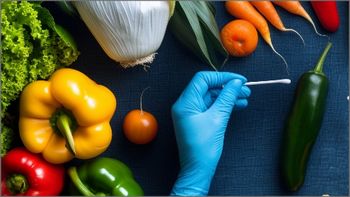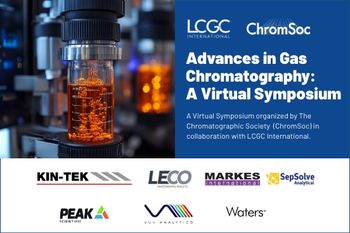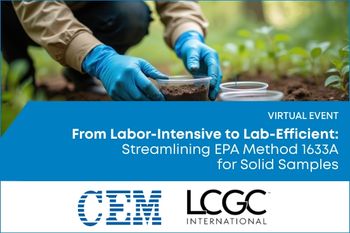
- The Column-07-08-2020
- Volume 16
- Issue 7
Understanding Microplastic Leaching
Microplastic pollution in the environment is a major concern for governments and companies worldwide attempting to understand and reduce the damage they cause. As well as the direct damage these plastic pellets can also act as chemical reservoirs that leach chemical contaminants into the environment and further damage ecosystems. The Column spoke to Manuel Miró from the University of the Balearic Islands, Spain, about his research into the pollution caused by chemical leaching from microplastics.
Q. The issue of microplastic pollution in the environment is very well documented but the issue of plastic additives leaching is not as well understood. What is microplastic leaching exactly and what kind of issues does it present?
A: It is true that most of the research efforts in this field have been directed towards the identification and (semi)quantitative analysis of the various types of plastic pellets in aquatic settings and environmental solids. The investigation of toxicity issues in aquatic biota has also attracted interest but the plastics are just seen as physical barriers or contaminants. Microplastic leaching stands for the evaluation of the release of chemical contaminants contained or adsorbed on the solid pellets using a variety of solvents and solutions, and serves to identify the potential role of plastic pellets as vectors of chemical contaminants. Leaching of contaminants from solid substrates is the first step towards deleterious effects onto biota and human health.
Q. In your recent paper you talk specifically about phthalate esters and bisphenol A (BPA) (1). Where do these chemicals originate from, and what dangers do they represent from an environmental contamination point-of-view?
A: Both types of compounds are added to plastics during the manufacturing process. Phthalate esters are used as plasticizers, that is, endowing flexibility and durability to the polymeric materials. Phthalates are considered endocrine disruptors at the low ng/L and µg/L levels, and thus, their use in toys and childcare products is already regulated.
Bisphenol A is another common organic species in polymer manufacturing and is used as an antioxidant or monomer in polycarbonate plastics. The high solubility in water makes it easily leachable into the aquatic environment or into food from polymer packaging. Bisphenol A is known as an estrogen agonist and androgen antagonist thus affects the human reproductive system.
Q. Are there any other notable chemicals which originate from microplastics?
A: Plastic materials launched to the market contain a number of chemicals from distinct classes that might migrate to the environment, including dyes and pigments, UV-filters, anti-oxidants and photoinitiators, just to name a few. Also, emerging contaminants that are replacing banned species, as is the case of Bisphenol S as a substitute of Bisphenol A, can now be found in aquatic settings and biota as a marker of plastic contamination.
Q. You developed an automatic flow-based platform hyphenated to on-line liquid chromatography for investigating the leachability of chemical additives from microplastics? What is novel about this new method (1)?
A: We have proposed for the first time a fully automatic flow injection method that is able to mimic the leachability of plastic additives from microplastics, such as polyethylene and polyvinylchloride, into seawater which is used as a leaching solution under dynamic conditions. This gives us invaluable information relating to the kinetics of release of the target compounds, and also allows the coupling of on-line leachability methods with matrix clean-up, which is the removal of salts by micro-solid phase extraction, and injection of preconcentrated species in high performance liquid chromatography (HPLC).
Q. Can you elaborate on the LC component of this method?
A: We have harnessed to a multi-dimensional separation system by using a short reversed-phase monolithic column for sorptive retention of the leached species in seawater and removal of salt components under flow‑injection conditions followed by switching-valve injection into an analytical column for HPLC separation.
Q. How does this approach benefit the analyst?
A: The on-line hyphenation of sample/extract clean-up with HPLC separation simplifies the analytical workflow and avoids manual treatment steps that might be a source of phthalate contamination.
Q. What challenges did you have to overcome to create this method?
A: The main challenges faced were the difficulty of handling plastic pellets in the flow system, minimizing the contamination issues from the components of the flow setup, and avoiding losses of the leached compounds by sorption onto the tubing of the system.
Q. What steps did you take to overcome these issues?
A: We used a stainless-steel (rather than polymeric) container for packing of the microplastics onto melamine foam that worked as a frit, and included a make-up flow for mixing the seawater eluate with 25% isopropanol for stabilization of the phthalate ester compounds in the way toward the clean-up column.
Q. How did the system perform and what benefits does it offer the analyst?
A: As indicated above, the flow setup operates fully unsupervised because it is controlled by user-friendly software, and integrates dynamic chemical leaching with on-line sample processing of the extracts by sorptive microextraction followed by chromatographic separation. The same system is adaptable to study any type of plastic materials, and plastic-containing solids using leaching solutions to meet the analyst’s requirements.
Q. Where else do you believe this method could be useful?
A: The automatic leaching method can be translated to any type of solid sample where bioaccessibility or migration tests of (toxic) organic compounds will be studied and this includes environmental solids, including, sediments, soil, airborne particulate matter, sewage sludge, etc., biological tissues and food commodities, such as mussels, fish, pulse, and other food commodities.
Q. What are you currently working on?
A: We are expanding the applicability of the proposed flow system to evaluate human risks derived from the accidental foodborne ingestion of microplastics that are seen as emerging contaminants. In fact, I am currently coordinating a Spanish Network of Excellence on the impact of emerging contaminants in marine settings, granted by the Spanish State Research Agency (CTM2017-90890-REDT, MICINN/AEI/FEDER/EU).
Reference
- K. Fikarová, D.J. Cocovi-Solberg, M. Rosende, B. Horstkotte, H. Sklenářová, and M. Miró, J. Chroma. A. 1602, 160–167 (2019).
Manuel Miró received his M.Sc. (1998) and Ph.D. (2002) in Chemistry at the University of the Balearic Islands (UIB), Spain. He is currently Full Professor in Analytical Chemistry at the UIB; Visiting Professor at Charles University (Czech Republic); and member of the International Union of Pure and Applied Chemistry (IUPAC), Chemistry and Environment Division (Subcommittee on Chemical and Biophysical Processes in the Environment). He is the Principal Investigator of the research group FI‑TRACE (Flow Injection and Trace Analysis) of the Department of Chemistry at UIB.
E-mail: manuel.miro@uib.es
Website:
Articles in this issue
over 5 years ago
ChromSoc Announce ‘Martin’ & ‘Jubilee’ Medal Winnersover 5 years ago
Vol 16 No 7 The Column July 2020 North American PDFover 5 years ago
Vol 16 No 7 The Column July 2020 Europe and Asia PDFover 5 years ago
Detecting Biomarkers in Breath using GC–MSover 5 years ago
The LCGC Blog: Last Dance, for a While—Time to Share the Wealthover 5 years ago
2D–LC Characterizes Synthetic Oligonucleotidesover 5 years ago
Determining Microplastic Accumulation Using Pyrolysis GC–MSover 5 years ago
Chromatographic Innovations for Cell TherapiesNewsletter
Join the global community of analytical scientists who trust LCGC for insights on the latest techniques, trends, and expert solutions in chromatography.





